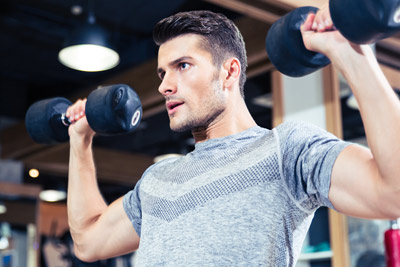 You love the way your shoulders look and feel when they are big, strong and healthy—that’s why you need to work your front, middle and rear deltoids to help you be fit.
You love the way your shoulders look and feel when they are big, strong and healthy—that’s why you need to work your front, middle and rear deltoids to help you be fit.
When you look in the mirror, what you see is the meaty fronts (anterior) and middle (medial) sections of your shoulders. That’s probably why they tend to get most of your attention at the gym. But we know you want to look good from behind in that tank top, too.
So don’t make the mistake of neglecting the rear (posterior) delts! They are often shortchanged in strength training simply because popular chest and shoulder presses hit the anterior and medial muscles.
Here are four exercises you can include in your routine on upper body days, to hit your deltoid muscles all the way around.
Seated Dumbbell Shoulder Press
- What it works: Front, middle and rear deltoids
- Why do it?: You can anchor your deltoid routine with this exercise, rotated with the overhead barbell press you might already be doing. The seated dumbbell press offers a couple of key benefits over the barbell or machine versions: more coordination is required and strength imbalances are avoided. Plus, using dumbbells allows your arms to flare out a bit more to your sides, which brings extra focus on the middle delts.
- How to do it: Sit on a low-back bench, holding a dumbbell in each hand above shoulder level. Grip with your palms facing forward. Keep your head straight, spine aligned and eyes focused forward and your shoulders open and shifted back. As you press the dumbbells overhead, they will gently arc toward each other — but don’t let them touch at the top. After a short squeeze, carefully reverse the motion back to the start position.
Bent-Over Dumbbell Lateral Raise
- What it works: Rear deltoids
- Why do it?: While the single-arm version of this lateral raise increases your chance to compensate (or “cheat”) by rotating at the waist, using both arms at the same time cuts down on that kind of momentum, and puts pressure on your rear delts to carry the load.
Plus, whether standing or seated at the end of a bench, using dumbbells brings more muscles into play for stabilization, which helps you create a more functional physique overall. - How to do it: Start with your chest up, back flat, knees slightly bent and eyes fixed on a point on the floor just ahead of you. With a dumbbell in each hand, bend over at the hips to bring your torso closer to the floor. Let the dumbbells hang directly beneath you with your elbows slightly bent and fixed, then raise the dumbbells up and out to your sides until your upper arms are almost parallel with the floor. Pause at the top, then lower the dumbbells back along the same path, stop briefly and then start the next rep.
One-Arm Cable Lateral Raise
- What it works: Middle deltoids
- Why do it?: Cable exercises offer constant tension, and this one targets the prominent middle delt, which splits the center of the deltoid muscle. It’s also relatively easy to use the pin on the weight stack to switch resistance and perform drop sets to failure. When you’re ready for some variety, try these lateral raises with the cable running behind your back (versus in front of your body).
- How to do it: Stand with your side facing a low cable pulley and your feet shoulder-width apart. Hold the D-shaped handle in the hand opposite the pulley and brace your non-working arm on your hip. Raise the cable out to your side in a wide arc, and avoid momentum by keeping your chest up, shoulders back, and abs engaged. Your elbow and hand should move together until your arm reaches a point just above shoulder level. Hold/squeeze the delt for a moment, then slowly lower down along the same path, stopping before the stack touches down. Finish reps on one side before switching to the other.
One-Arm Cable Front Raise
- What it works: Front deltoids
- Why do it?: When you perform lateral movements across your body with the cable, the drag can make for awkward performance. But with front raises, which allow the cable to roam free during the full range of motion, you’ll eliminate this distraction when repping, allowing more focus on the powerful contraction of the front delts when you do.
- How to do it: Stand with your back facing a low cable pulley, stagger your stance (shoulder-width) and hold the D-shaped handle in one hand, palm facing back, with your nonworking hand on your hip for balance. Bend slightly at the knees, lift your chest and keep your back flat as you raise the cable up and out in front of you until your upper arm is about even with your shoulder. Pause at the top and then slowly lower your arm back to the starting position without letting the stack touch down, and repeat. Do all reps on one side before switching to the other.


